Case Study: Civil and Criminal Remedies for Domestic Violence Victims
VerifiedAdded on 2023/04/21
|21
|5814
|121
Case Study
AI Summary
This case study examines the issue of domestic violence in England and Wales, focusing on available civil and criminal remedies for victims. It begins by defining domestic violence and highlighting its prevalence, supported by statistics from the Crime Survey for England and Wales (CSEW). The study then draws a comparison with the situation in the United States, noting similarities and differences in the legal and social responses to domestic violence. It further explores the possible explanations for the continued prevalence of domestic violence, emphasizing the significant emotional, social, and economic costs. The case study concludes by underscoring the urgent need for effective interventions and support systems to protect victims and prevent future incidents of domestic violence.

Civil and Criminal Remedies for Domestic
Violence Victims in England and Wales
Violence Victims in England and Wales
Paraphrase This Document
Need a fresh take? Get an instant paraphrase of this document with our AI Paraphraser
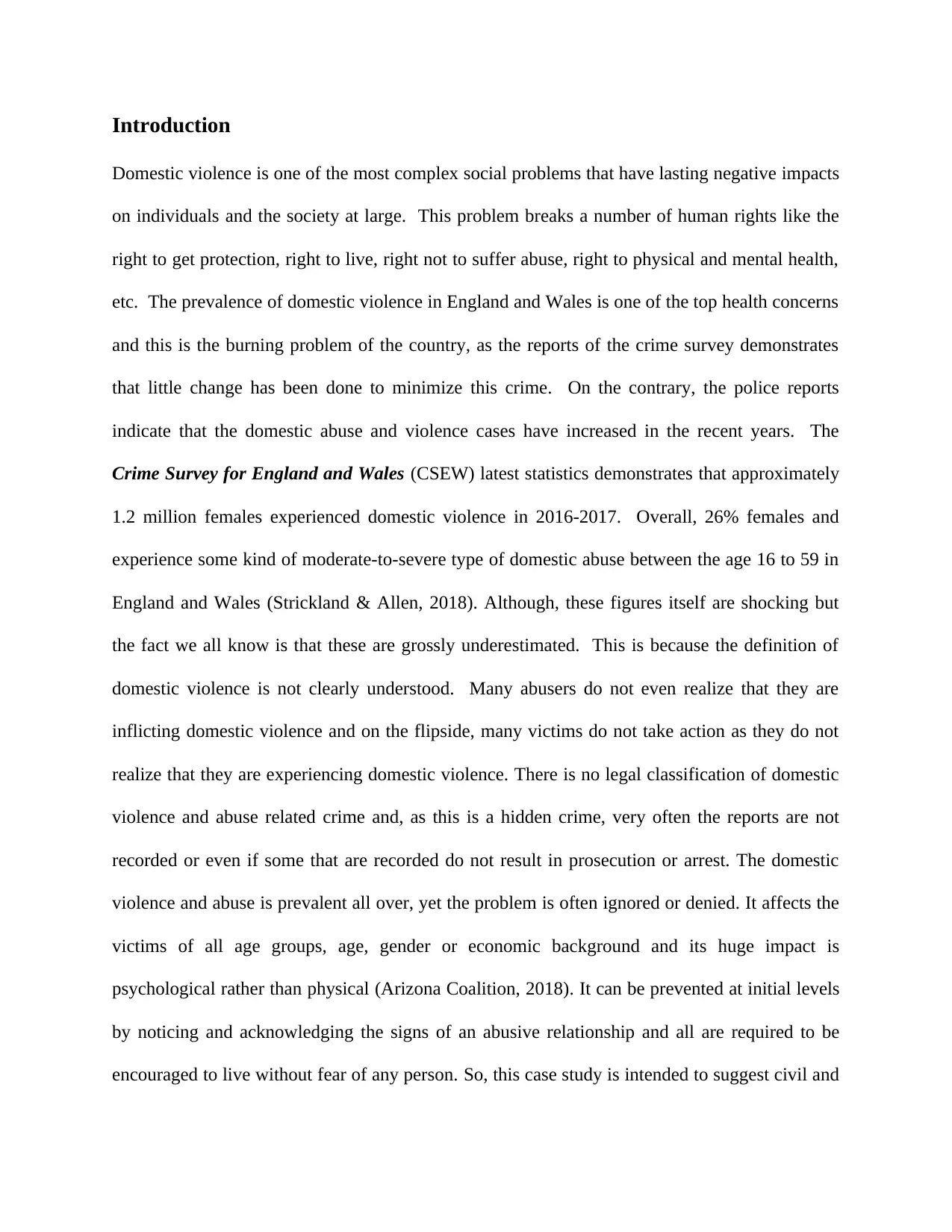
Introduction
Domestic violence is one of the most complex social problems that have lasting negative impacts
on individuals and the society at large. This problem breaks a number of human rights like the
right to get protection, right to live, right not to suffer abuse, right to physical and mental health,
etc. The prevalence of domestic violence in England and Wales is one of the top health concerns
and this is the burning problem of the country, as the reports of the crime survey demonstrates
that little change has been done to minimize this crime. On the contrary, the police reports
indicate that the domestic abuse and violence cases have increased in the recent years. The
Crime Survey for England and Wales (CSEW) latest statistics demonstrates that approximately
1.2 million females experienced domestic violence in 2016-2017. Overall, 26% females and
experience some kind of moderate-to-severe type of domestic abuse between the age 16 to 59 in
England and Wales (Strickland & Allen, 2018). Although, these figures itself are shocking but
the fact we all know is that these are grossly underestimated. This is because the definition of
domestic violence is not clearly understood. Many abusers do not even realize that they are
inflicting domestic violence and on the flipside, many victims do not take action as they do not
realize that they are experiencing domestic violence. There is no legal classification of domestic
violence and abuse related crime and, as this is a hidden crime, very often the reports are not
recorded or even if some that are recorded do not result in prosecution or arrest. The domestic
violence and abuse is prevalent all over, yet the problem is often ignored or denied. It affects the
victims of all age groups, age, gender or economic background and its huge impact is
psychological rather than physical (Arizona Coalition, 2018). It can be prevented at initial levels
by noticing and acknowledging the signs of an abusive relationship and all are required to be
encouraged to live without fear of any person. So, this case study is intended to suggest civil and
Domestic violence is one of the most complex social problems that have lasting negative impacts
on individuals and the society at large. This problem breaks a number of human rights like the
right to get protection, right to live, right not to suffer abuse, right to physical and mental health,
etc. The prevalence of domestic violence in England and Wales is one of the top health concerns
and this is the burning problem of the country, as the reports of the crime survey demonstrates
that little change has been done to minimize this crime. On the contrary, the police reports
indicate that the domestic abuse and violence cases have increased in the recent years. The
Crime Survey for England and Wales (CSEW) latest statistics demonstrates that approximately
1.2 million females experienced domestic violence in 2016-2017. Overall, 26% females and
experience some kind of moderate-to-severe type of domestic abuse between the age 16 to 59 in
England and Wales (Strickland & Allen, 2018). Although, these figures itself are shocking but
the fact we all know is that these are grossly underestimated. This is because the definition of
domestic violence is not clearly understood. Many abusers do not even realize that they are
inflicting domestic violence and on the flipside, many victims do not take action as they do not
realize that they are experiencing domestic violence. There is no legal classification of domestic
violence and abuse related crime and, as this is a hidden crime, very often the reports are not
recorded or even if some that are recorded do not result in prosecution or arrest. The domestic
violence and abuse is prevalent all over, yet the problem is often ignored or denied. It affects the
victims of all age groups, age, gender or economic background and its huge impact is
psychological rather than physical (Arizona Coalition, 2018). It can be prevented at initial levels
by noticing and acknowledging the signs of an abusive relationship and all are required to be
encouraged to live without fear of any person. So, this case study is intended to suggest civil and
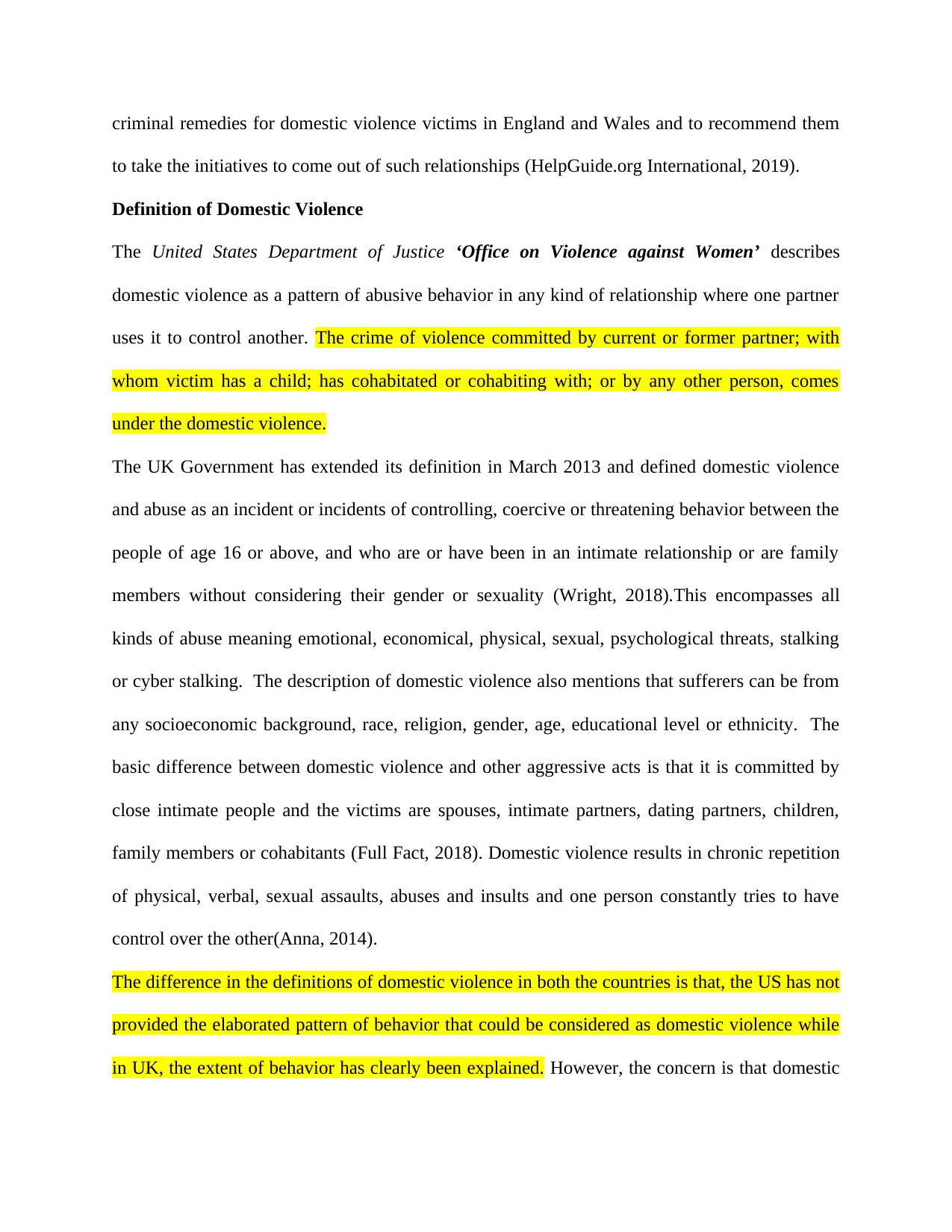
criminal remedies for domestic violence victims in England and Wales and to recommend them
to take the initiatives to come out of such relationships (HelpGuide.org International, 2019).
Definition of Domestic Violence
The United States Department of Justice ‘Office on Violence against Women’ describes
domestic violence as a pattern of abusive behavior in any kind of relationship where one partner
uses it to control another. The crime of violence committed by current or former partner; with
whom victim has a child; has cohabitated or cohabiting with; or by any other person, comes
under the domestic violence.
The UK Government has extended its definition in March 2013 and defined domestic violence
and abuse as an incident or incidents of controlling, coercive or threatening behavior between the
people of age 16 or above, and who are or have been in an intimate relationship or are family
members without considering their gender or sexuality (Wright, 2018).This encompasses all
kinds of abuse meaning emotional, economical, physical, sexual, psychological threats, stalking
or cyber stalking. The description of domestic violence also mentions that sufferers can be from
any socioeconomic background, race, religion, gender, age, educational level or ethnicity. The
basic difference between domestic violence and other aggressive acts is that it is committed by
close intimate people and the victims are spouses, intimate partners, dating partners, children,
family members or cohabitants (Full Fact, 2018). Domestic violence results in chronic repetition
of physical, verbal, sexual assaults, abuses and insults and one person constantly tries to have
control over the other(Anna, 2014).
The difference in the definitions of domestic violence in both the countries is that, the US has not
provided the elaborated pattern of behavior that could be considered as domestic violence while
in UK, the extent of behavior has clearly been explained. However, the concern is that domestic
to take the initiatives to come out of such relationships (HelpGuide.org International, 2019).
Definition of Domestic Violence
The United States Department of Justice ‘Office on Violence against Women’ describes
domestic violence as a pattern of abusive behavior in any kind of relationship where one partner
uses it to control another. The crime of violence committed by current or former partner; with
whom victim has a child; has cohabitated or cohabiting with; or by any other person, comes
under the domestic violence.
The UK Government has extended its definition in March 2013 and defined domestic violence
and abuse as an incident or incidents of controlling, coercive or threatening behavior between the
people of age 16 or above, and who are or have been in an intimate relationship or are family
members without considering their gender or sexuality (Wright, 2018).This encompasses all
kinds of abuse meaning emotional, economical, physical, sexual, psychological threats, stalking
or cyber stalking. The description of domestic violence also mentions that sufferers can be from
any socioeconomic background, race, religion, gender, age, educational level or ethnicity. The
basic difference between domestic violence and other aggressive acts is that it is committed by
close intimate people and the victims are spouses, intimate partners, dating partners, children,
family members or cohabitants (Full Fact, 2018). Domestic violence results in chronic repetition
of physical, verbal, sexual assaults, abuses and insults and one person constantly tries to have
control over the other(Anna, 2014).
The difference in the definitions of domestic violence in both the countries is that, the US has not
provided the elaborated pattern of behavior that could be considered as domestic violence while
in UK, the extent of behavior has clearly been explained. However, the concern is that domestic
⊘ This is a preview!⊘
Do you want full access?
Subscribe today to unlock all pages.

Trusted by 1+ million students worldwide
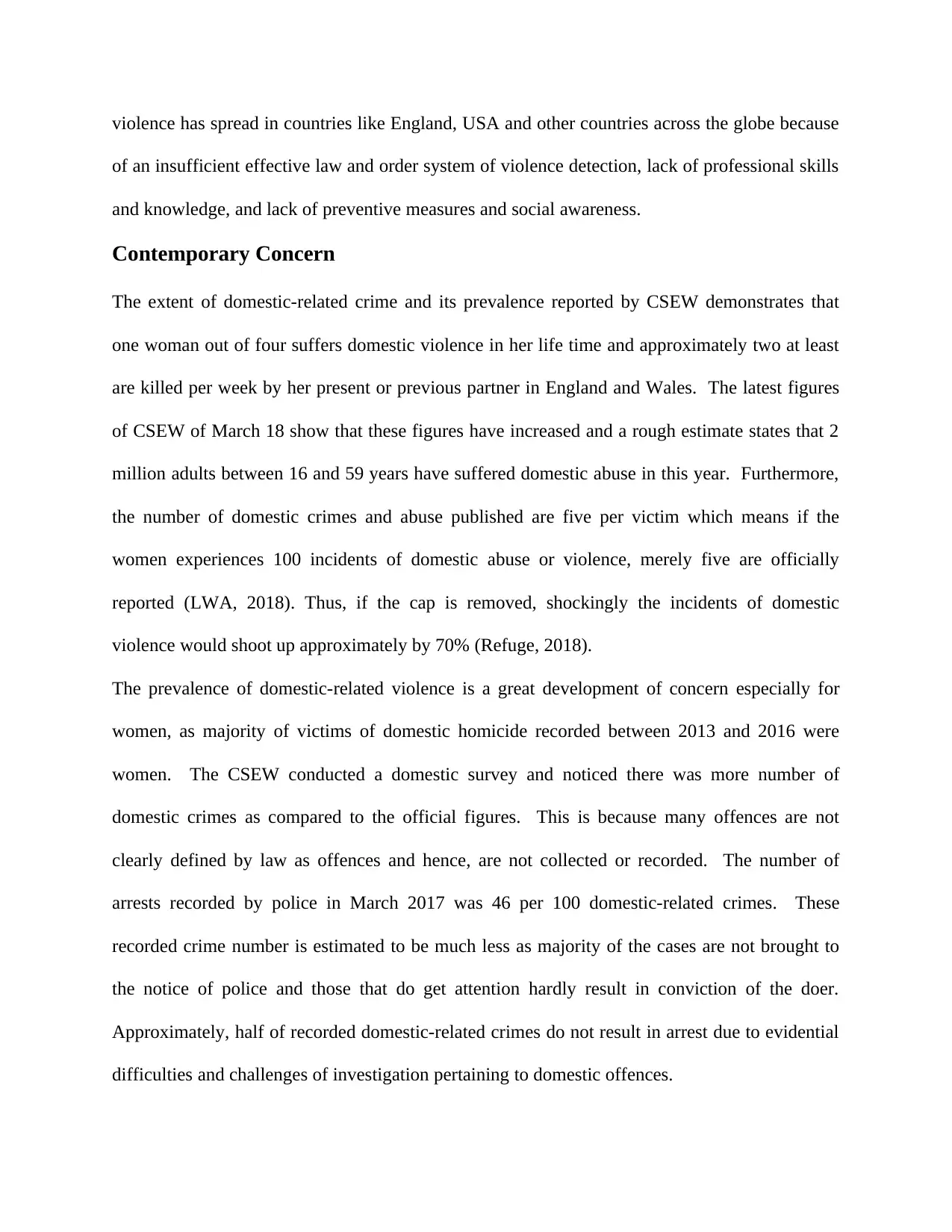
violence has spread in countries like England, USA and other countries across the globe because
of an insufficient effective law and order system of violence detection, lack of professional skills
and knowledge, and lack of preventive measures and social awareness.
Contemporary Concern
The extent of domestic-related crime and its prevalence reported by CSEW demonstrates that
one woman out of four suffers domestic violence in her life time and approximately two at least
are killed per week by her present or previous partner in England and Wales. The latest figures
of CSEW of March 18 show that these figures have increased and a rough estimate states that 2
million adults between 16 and 59 years have suffered domestic abuse in this year. Furthermore,
the number of domestic crimes and abuse published are five per victim which means if the
women experiences 100 incidents of domestic abuse or violence, merely five are officially
reported (LWA, 2018). Thus, if the cap is removed, shockingly the incidents of domestic
violence would shoot up approximately by 70% (Refuge, 2018).
The prevalence of domestic-related violence is a great development of concern especially for
women, as majority of victims of domestic homicide recorded between 2013 and 2016 were
women. The CSEW conducted a domestic survey and noticed there was more number of
domestic crimes as compared to the official figures. This is because many offences are not
clearly defined by law as offences and hence, are not collected or recorded. The number of
arrests recorded by police in March 2017 was 46 per 100 domestic-related crimes. These
recorded crime number is estimated to be much less as majority of the cases are not brought to
the notice of police and those that do get attention hardly result in conviction of the doer.
Approximately, half of recorded domestic-related crimes do not result in arrest due to evidential
difficulties and challenges of investigation pertaining to domestic offences.
of an insufficient effective law and order system of violence detection, lack of professional skills
and knowledge, and lack of preventive measures and social awareness.
Contemporary Concern
The extent of domestic-related crime and its prevalence reported by CSEW demonstrates that
one woman out of four suffers domestic violence in her life time and approximately two at least
are killed per week by her present or previous partner in England and Wales. The latest figures
of CSEW of March 18 show that these figures have increased and a rough estimate states that 2
million adults between 16 and 59 years have suffered domestic abuse in this year. Furthermore,
the number of domestic crimes and abuse published are five per victim which means if the
women experiences 100 incidents of domestic abuse or violence, merely five are officially
reported (LWA, 2018). Thus, if the cap is removed, shockingly the incidents of domestic
violence would shoot up approximately by 70% (Refuge, 2018).
The prevalence of domestic-related violence is a great development of concern especially for
women, as majority of victims of domestic homicide recorded between 2013 and 2016 were
women. The CSEW conducted a domestic survey and noticed there was more number of
domestic crimes as compared to the official figures. This is because many offences are not
clearly defined by law as offences and hence, are not collected or recorded. The number of
arrests recorded by police in March 2017 was 46 per 100 domestic-related crimes. These
recorded crime number is estimated to be much less as majority of the cases are not brought to
the notice of police and those that do get attention hardly result in conviction of the doer.
Approximately, half of recorded domestic-related crimes do not result in arrest due to evidential
difficulties and challenges of investigation pertaining to domestic offences.
Paraphrase This Document
Need a fresh take? Get an instant paraphrase of this document with our AI Paraphraser
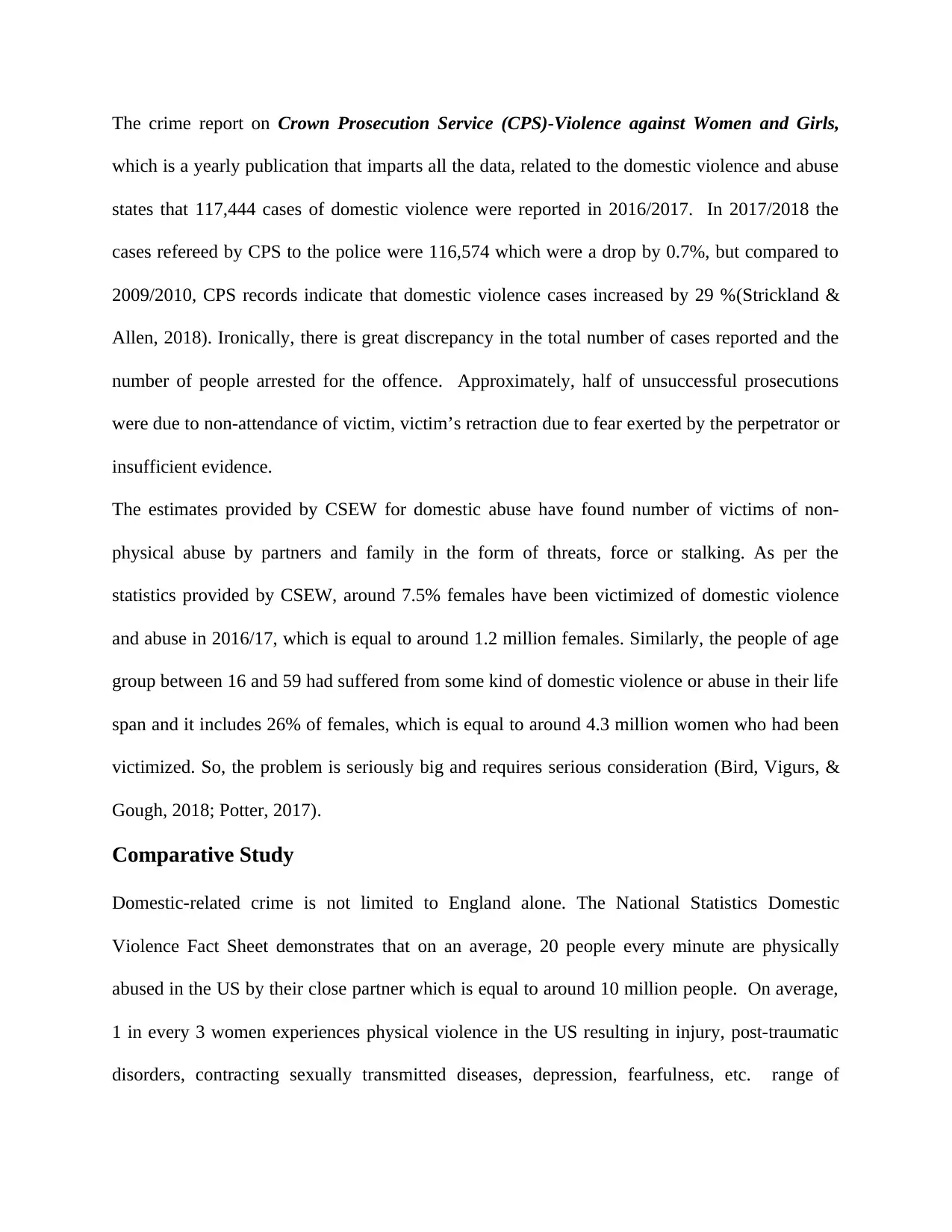
The crime report on Crown Prosecution Service (CPS)-Violence against Women and Girls,
which is a yearly publication that imparts all the data, related to the domestic violence and abuse
states that 117,444 cases of domestic violence were reported in 2016/2017. In 2017/2018 the
cases refereed by CPS to the police were 116,574 which were a drop by 0.7%, but compared to
2009/2010, CPS records indicate that domestic violence cases increased by 29 %(Strickland &
Allen, 2018). Ironically, there is great discrepancy in the total number of cases reported and the
number of people arrested for the offence. Approximately, half of unsuccessful prosecutions
were due to non-attendance of victim, victim’s retraction due to fear exerted by the perpetrator or
insufficient evidence.
The estimates provided by CSEW for domestic abuse have found number of victims of non-
physical abuse by partners and family in the form of threats, force or stalking. As per the
statistics provided by CSEW, around 7.5% females have been victimized of domestic violence
and abuse in 2016/17, which is equal to around 1.2 million females. Similarly, the people of age
group between 16 and 59 had suffered from some kind of domestic violence or abuse in their life
span and it includes 26% of females, which is equal to around 4.3 million women who had been
victimized. So, the problem is seriously big and requires serious consideration (Bird, Vigurs, &
Gough, 2018; Potter, 2017).
Comparative Study
Domestic-related crime is not limited to England alone. The National Statistics Domestic
Violence Fact Sheet demonstrates that on an average, 20 people every minute are physically
abused in the US by their close partner which is equal to around 10 million people. On average,
1 in every 3 women experiences physical violence in the US resulting in injury, post-traumatic
disorders, contracting sexually transmitted diseases, depression, fearfulness, etc. range of
which is a yearly publication that imparts all the data, related to the domestic violence and abuse
states that 117,444 cases of domestic violence were reported in 2016/2017. In 2017/2018 the
cases refereed by CPS to the police were 116,574 which were a drop by 0.7%, but compared to
2009/2010, CPS records indicate that domestic violence cases increased by 29 %(Strickland &
Allen, 2018). Ironically, there is great discrepancy in the total number of cases reported and the
number of people arrested for the offence. Approximately, half of unsuccessful prosecutions
were due to non-attendance of victim, victim’s retraction due to fear exerted by the perpetrator or
insufficient evidence.
The estimates provided by CSEW for domestic abuse have found number of victims of non-
physical abuse by partners and family in the form of threats, force or stalking. As per the
statistics provided by CSEW, around 7.5% females have been victimized of domestic violence
and abuse in 2016/17, which is equal to around 1.2 million females. Similarly, the people of age
group between 16 and 59 had suffered from some kind of domestic violence or abuse in their life
span and it includes 26% of females, which is equal to around 4.3 million women who had been
victimized. So, the problem is seriously big and requires serious consideration (Bird, Vigurs, &
Gough, 2018; Potter, 2017).
Comparative Study
Domestic-related crime is not limited to England alone. The National Statistics Domestic
Violence Fact Sheet demonstrates that on an average, 20 people every minute are physically
abused in the US by their close partner which is equal to around 10 million people. On average,
1 in every 3 women experiences physical violence in the US resulting in injury, post-traumatic
disorders, contracting sexually transmitted diseases, depression, fearfulness, etc. range of
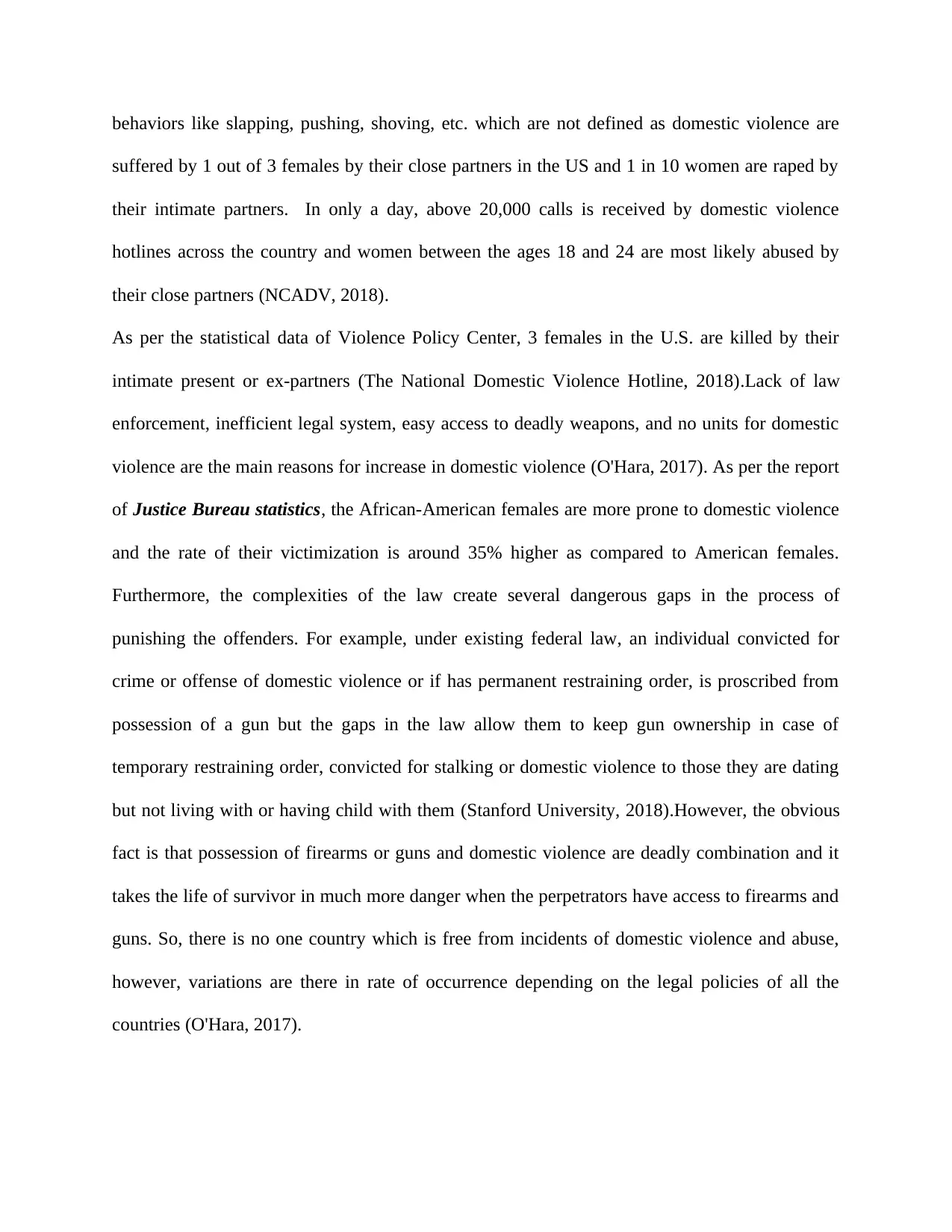
behaviors like slapping, pushing, shoving, etc. which are not defined as domestic violence are
suffered by 1 out of 3 females by their close partners in the US and 1 in 10 women are raped by
their intimate partners. In only a day, above 20,000 calls is received by domestic violence
hotlines across the country and women between the ages 18 and 24 are most likely abused by
their close partners (NCADV, 2018).
As per the statistical data of Violence Policy Center, 3 females in the U.S. are killed by their
intimate present or ex-partners (The National Domestic Violence Hotline, 2018).Lack of law
enforcement, inefficient legal system, easy access to deadly weapons, and no units for domestic
violence are the main reasons for increase in domestic violence (O'Hara, 2017). As per the report
of Justice Bureau statistics, the African-American females are more prone to domestic violence
and the rate of their victimization is around 35% higher as compared to American females.
Furthermore, the complexities of the law create several dangerous gaps in the process of
punishing the offenders. For example, under existing federal law, an individual convicted for
crime or offense of domestic violence or if has permanent restraining order, is proscribed from
possession of a gun but the gaps in the law allow them to keep gun ownership in case of
temporary restraining order, convicted for stalking or domestic violence to those they are dating
but not living with or having child with them (Stanford University, 2018).However, the obvious
fact is that possession of firearms or guns and domestic violence are deadly combination and it
takes the life of survivor in much more danger when the perpetrators have access to firearms and
guns. So, there is no one country which is free from incidents of domestic violence and abuse,
however, variations are there in rate of occurrence depending on the legal policies of all the
countries (O'Hara, 2017).
suffered by 1 out of 3 females by their close partners in the US and 1 in 10 women are raped by
their intimate partners. In only a day, above 20,000 calls is received by domestic violence
hotlines across the country and women between the ages 18 and 24 are most likely abused by
their close partners (NCADV, 2018).
As per the statistical data of Violence Policy Center, 3 females in the U.S. are killed by their
intimate present or ex-partners (The National Domestic Violence Hotline, 2018).Lack of law
enforcement, inefficient legal system, easy access to deadly weapons, and no units for domestic
violence are the main reasons for increase in domestic violence (O'Hara, 2017). As per the report
of Justice Bureau statistics, the African-American females are more prone to domestic violence
and the rate of their victimization is around 35% higher as compared to American females.
Furthermore, the complexities of the law create several dangerous gaps in the process of
punishing the offenders. For example, under existing federal law, an individual convicted for
crime or offense of domestic violence or if has permanent restraining order, is proscribed from
possession of a gun but the gaps in the law allow them to keep gun ownership in case of
temporary restraining order, convicted for stalking or domestic violence to those they are dating
but not living with or having child with them (Stanford University, 2018).However, the obvious
fact is that possession of firearms or guns and domestic violence are deadly combination and it
takes the life of survivor in much more danger when the perpetrators have access to firearms and
guns. So, there is no one country which is free from incidents of domestic violence and abuse,
however, variations are there in rate of occurrence depending on the legal policies of all the
countries (O'Hara, 2017).
⊘ This is a preview!⊘
Do you want full access?
Subscribe today to unlock all pages.

Trusted by 1+ million students worldwide
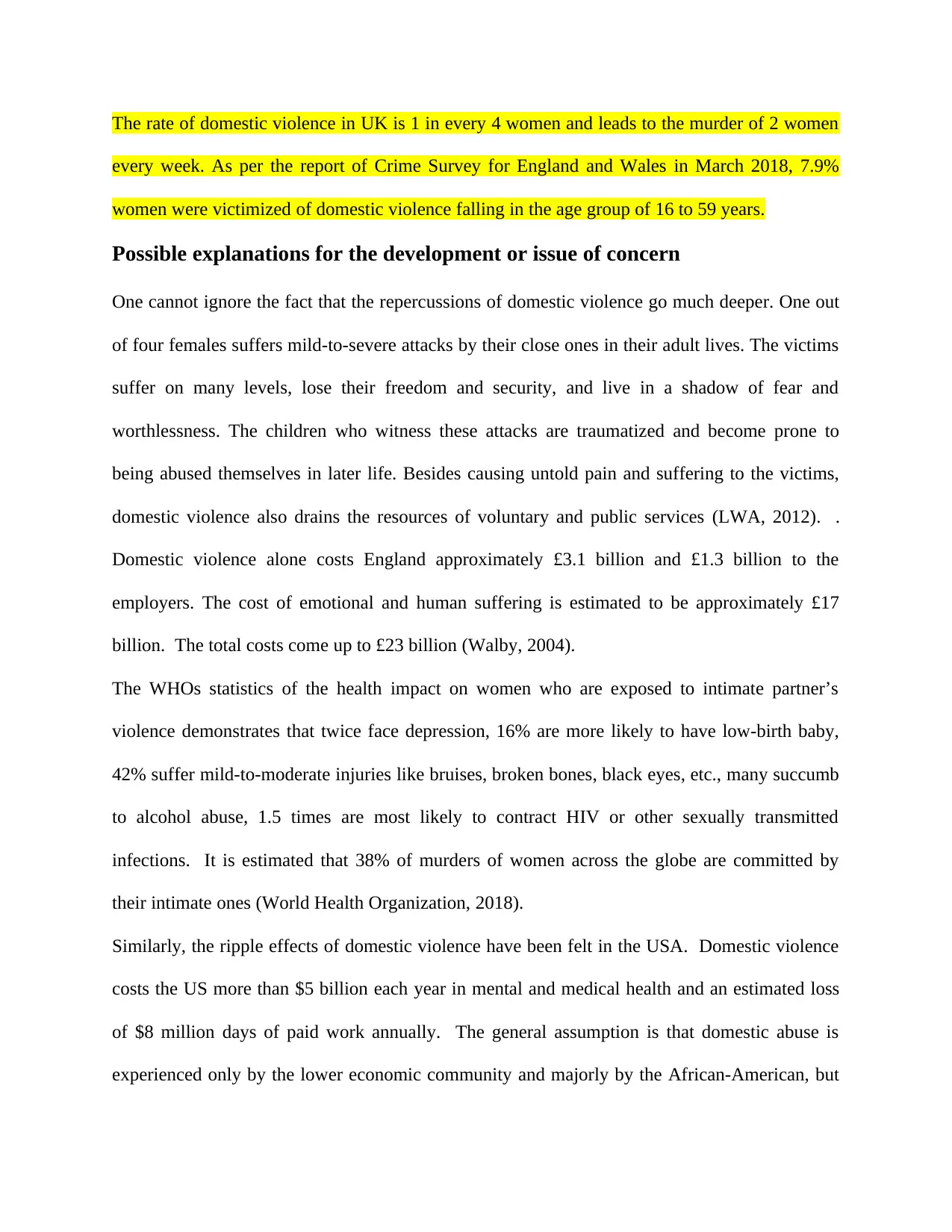
The rate of domestic violence in UK is 1 in every 4 women and leads to the murder of 2 women
every week. As per the report of Crime Survey for England and Wales in March 2018, 7.9%
women were victimized of domestic violence falling in the age group of 16 to 59 years.
Possible explanations for the development or issue of concern
One cannot ignore the fact that the repercussions of domestic violence go much deeper. One out
of four females suffers mild-to-severe attacks by their close ones in their adult lives. The victims
suffer on many levels, lose their freedom and security, and live in a shadow of fear and
worthlessness. The children who witness these attacks are traumatized and become prone to
being abused themselves in later life. Besides causing untold pain and suffering to the victims,
domestic violence also drains the resources of voluntary and public services (LWA, 2012). .
Domestic violence alone costs England approximately £3.1 billion and £1.3 billion to the
employers. The cost of emotional and human suffering is estimated to be approximately £17
billion. The total costs come up to £23 billion (Walby, 2004).
The WHOs statistics of the health impact on women who are exposed to intimate partner’s
violence demonstrates that twice face depression, 16% are more likely to have low-birth baby,
42% suffer mild-to-moderate injuries like bruises, broken bones, black eyes, etc., many succumb
to alcohol abuse, 1.5 times are most likely to contract HIV or other sexually transmitted
infections. It is estimated that 38% of murders of women across the globe are committed by
their intimate ones (World Health Organization, 2018).
Similarly, the ripple effects of domestic violence have been felt in the USA. Domestic violence
costs the US more than $5 billion each year in mental and medical health and an estimated loss
of $8 million days of paid work annually. The general assumption is that domestic abuse is
experienced only by the lower economic community and majorly by the African-American, but
every week. As per the report of Crime Survey for England and Wales in March 2018, 7.9%
women were victimized of domestic violence falling in the age group of 16 to 59 years.
Possible explanations for the development or issue of concern
One cannot ignore the fact that the repercussions of domestic violence go much deeper. One out
of four females suffers mild-to-severe attacks by their close ones in their adult lives. The victims
suffer on many levels, lose their freedom and security, and live in a shadow of fear and
worthlessness. The children who witness these attacks are traumatized and become prone to
being abused themselves in later life. Besides causing untold pain and suffering to the victims,
domestic violence also drains the resources of voluntary and public services (LWA, 2012). .
Domestic violence alone costs England approximately £3.1 billion and £1.3 billion to the
employers. The cost of emotional and human suffering is estimated to be approximately £17
billion. The total costs come up to £23 billion (Walby, 2004).
The WHOs statistics of the health impact on women who are exposed to intimate partner’s
violence demonstrates that twice face depression, 16% are more likely to have low-birth baby,
42% suffer mild-to-moderate injuries like bruises, broken bones, black eyes, etc., many succumb
to alcohol abuse, 1.5 times are most likely to contract HIV or other sexually transmitted
infections. It is estimated that 38% of murders of women across the globe are committed by
their intimate ones (World Health Organization, 2018).
Similarly, the ripple effects of domestic violence have been felt in the USA. Domestic violence
costs the US more than $5 billion each year in mental and medical health and an estimated loss
of $8 million days of paid work annually. The general assumption is that domestic abuse is
experienced only by the lower economic community and majorly by the African-American, but
Paraphrase This Document
Need a fresh take? Get an instant paraphrase of this document with our AI Paraphraser
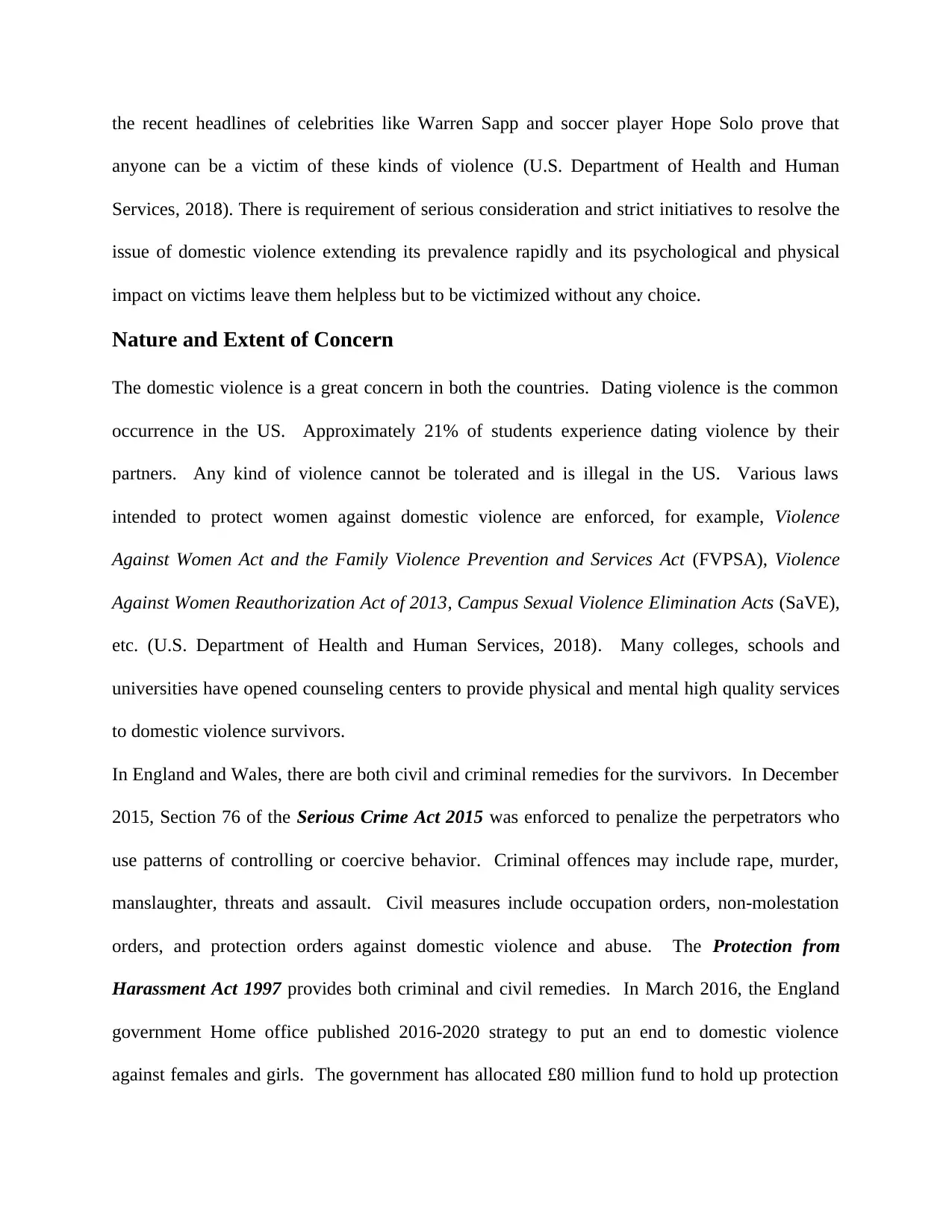
the recent headlines of celebrities like Warren Sapp and soccer player Hope Solo prove that
anyone can be a victim of these kinds of violence (U.S. Department of Health and Human
Services, 2018). There is requirement of serious consideration and strict initiatives to resolve the
issue of domestic violence extending its prevalence rapidly and its psychological and physical
impact on victims leave them helpless but to be victimized without any choice.
Nature and Extent of Concern
The domestic violence is a great concern in both the countries. Dating violence is the common
occurrence in the US. Approximately 21% of students experience dating violence by their
partners. Any kind of violence cannot be tolerated and is illegal in the US. Various laws
intended to protect women against domestic violence are enforced, for example, Violence
Against Women Act and the Family Violence Prevention and Services Act (FVPSA), Violence
Against Women Reauthorization Act of 2013, Campus Sexual Violence Elimination Acts (SaVE),
etc. (U.S. Department of Health and Human Services, 2018). Many colleges, schools and
universities have opened counseling centers to provide physical and mental high quality services
to domestic violence survivors.
In England and Wales, there are both civil and criminal remedies for the survivors. In December
2015, Section 76 of the Serious Crime Act 2015 was enforced to penalize the perpetrators who
use patterns of controlling or coercive behavior. Criminal offences may include rape, murder,
manslaughter, threats and assault. Civil measures include occupation orders, non-molestation
orders, and protection orders against domestic violence and abuse. The Protection from
Harassment Act 1997 provides both criminal and civil remedies. In March 2016, the England
government Home office published 2016-2020 strategy to put an end to domestic violence
against females and girls. The government has allocated £80 million fund to hold up protection
anyone can be a victim of these kinds of violence (U.S. Department of Health and Human
Services, 2018). There is requirement of serious consideration and strict initiatives to resolve the
issue of domestic violence extending its prevalence rapidly and its psychological and physical
impact on victims leave them helpless but to be victimized without any choice.
Nature and Extent of Concern
The domestic violence is a great concern in both the countries. Dating violence is the common
occurrence in the US. Approximately 21% of students experience dating violence by their
partners. Any kind of violence cannot be tolerated and is illegal in the US. Various laws
intended to protect women against domestic violence are enforced, for example, Violence
Against Women Act and the Family Violence Prevention and Services Act (FVPSA), Violence
Against Women Reauthorization Act of 2013, Campus Sexual Violence Elimination Acts (SaVE),
etc. (U.S. Department of Health and Human Services, 2018). Many colleges, schools and
universities have opened counseling centers to provide physical and mental high quality services
to domestic violence survivors.
In England and Wales, there are both civil and criminal remedies for the survivors. In December
2015, Section 76 of the Serious Crime Act 2015 was enforced to penalize the perpetrators who
use patterns of controlling or coercive behavior. Criminal offences may include rape, murder,
manslaughter, threats and assault. Civil measures include occupation orders, non-molestation
orders, and protection orders against domestic violence and abuse. The Protection from
Harassment Act 1997 provides both criminal and civil remedies. In March 2016, the England
government Home office published 2016-2020 strategy to put an end to domestic violence
against females and girls. The government has allocated £80 million fund to hold up protection
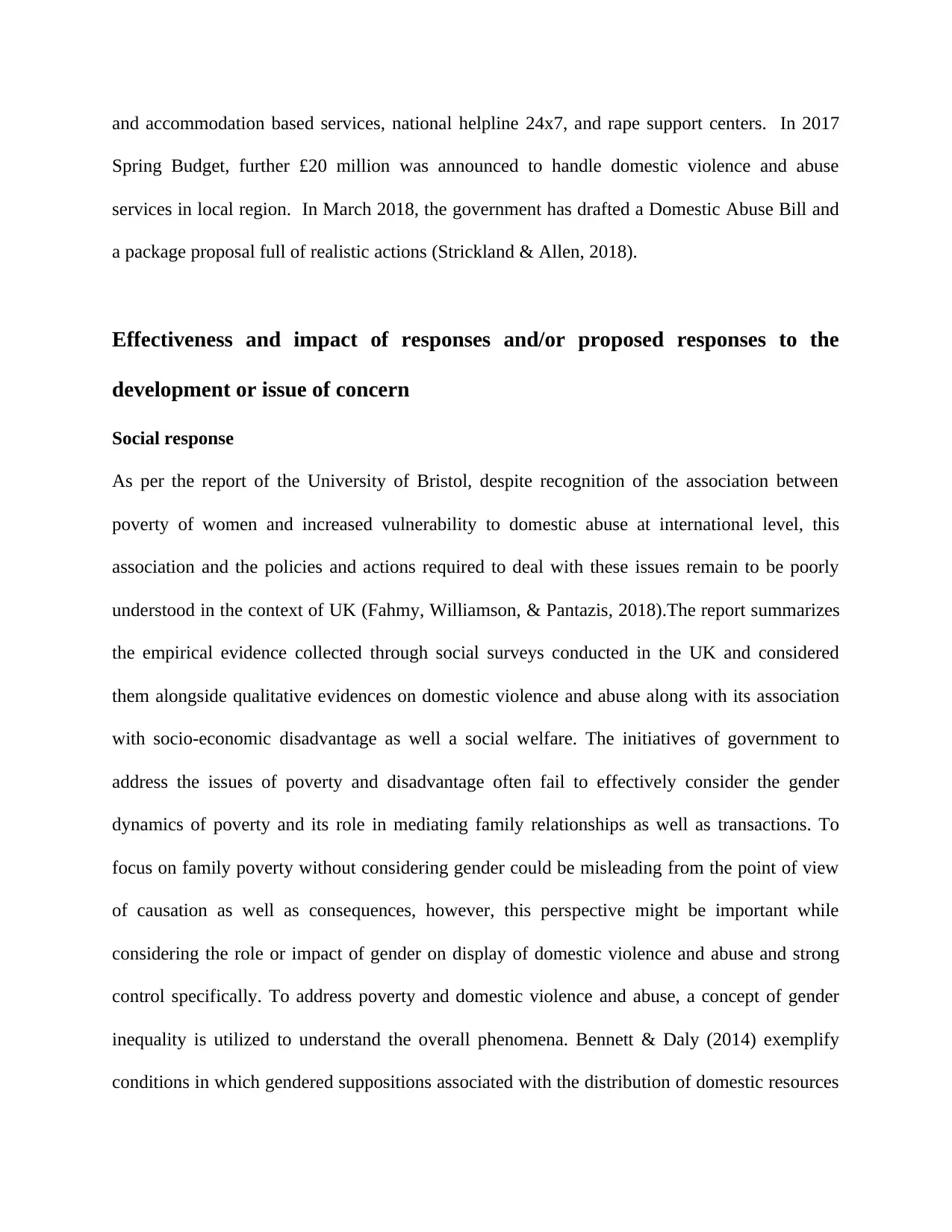
and accommodation based services, national helpline 24x7, and rape support centers. In 2017
Spring Budget, further £20 million was announced to handle domestic violence and abuse
services in local region. In March 2018, the government has drafted a Domestic Abuse Bill and
a package proposal full of realistic actions (Strickland & Allen, 2018).
Effectiveness and impact of responses and/or proposed responses to the
development or issue of concern
Social response
As per the report of the University of Bristol, despite recognition of the association between
poverty of women and increased vulnerability to domestic abuse at international level, this
association and the policies and actions required to deal with these issues remain to be poorly
understood in the context of UK (Fahmy, Williamson, & Pantazis, 2018).The report summarizes
the empirical evidence collected through social surveys conducted in the UK and considered
them alongside qualitative evidences on domestic violence and abuse along with its association
with socio-economic disadvantage as well a social welfare. The initiatives of government to
address the issues of poverty and disadvantage often fail to effectively consider the gender
dynamics of poverty and its role in mediating family relationships as well as transactions. To
focus on family poverty without considering gender could be misleading from the point of view
of causation as well as consequences, however, this perspective might be important while
considering the role or impact of gender on display of domestic violence and abuse and strong
control specifically. To address poverty and domestic violence and abuse, a concept of gender
inequality is utilized to understand the overall phenomena. Bennett & Daly (2014) exemplify
conditions in which gendered suppositions associated with the distribution of domestic resources
Spring Budget, further £20 million was announced to handle domestic violence and abuse
services in local region. In March 2018, the government has drafted a Domestic Abuse Bill and
a package proposal full of realistic actions (Strickland & Allen, 2018).
Effectiveness and impact of responses and/or proposed responses to the
development or issue of concern
Social response
As per the report of the University of Bristol, despite recognition of the association between
poverty of women and increased vulnerability to domestic abuse at international level, this
association and the policies and actions required to deal with these issues remain to be poorly
understood in the context of UK (Fahmy, Williamson, & Pantazis, 2018).The report summarizes
the empirical evidence collected through social surveys conducted in the UK and considered
them alongside qualitative evidences on domestic violence and abuse along with its association
with socio-economic disadvantage as well a social welfare. The initiatives of government to
address the issues of poverty and disadvantage often fail to effectively consider the gender
dynamics of poverty and its role in mediating family relationships as well as transactions. To
focus on family poverty without considering gender could be misleading from the point of view
of causation as well as consequences, however, this perspective might be important while
considering the role or impact of gender on display of domestic violence and abuse and strong
control specifically. To address poverty and domestic violence and abuse, a concept of gender
inequality is utilized to understand the overall phenomena. Bennett & Daly (2014) exemplify
conditions in which gendered suppositions associated with the distribution of domestic resources
⊘ This is a preview!⊘
Do you want full access?
Subscribe today to unlock all pages.

Trusted by 1+ million students worldwide
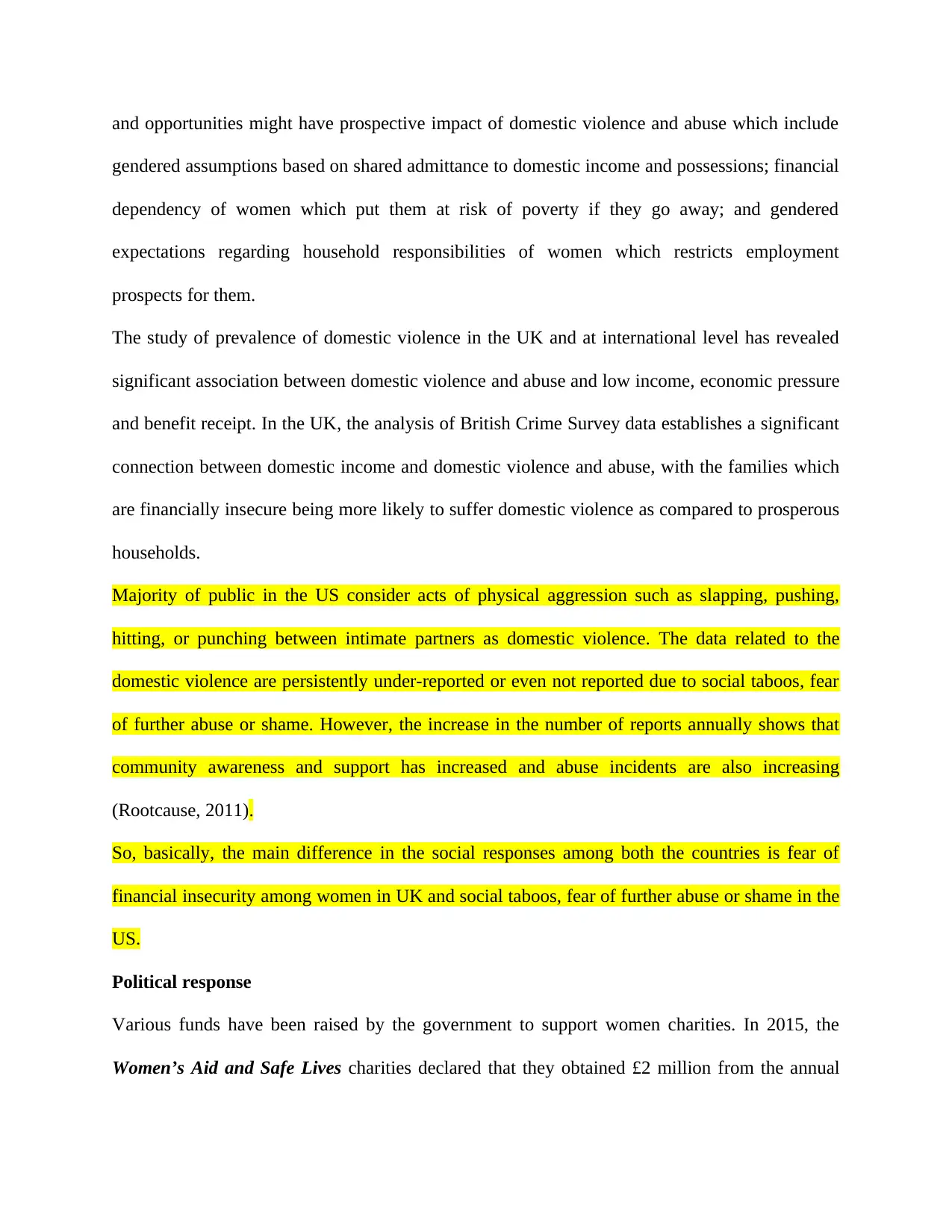
and opportunities might have prospective impact of domestic violence and abuse which include
gendered assumptions based on shared admittance to domestic income and possessions; financial
dependency of women which put them at risk of poverty if they go away; and gendered
expectations regarding household responsibilities of women which restricts employment
prospects for them.
The study of prevalence of domestic violence in the UK and at international level has revealed
significant association between domestic violence and abuse and low income, economic pressure
and benefit receipt. In the UK, the analysis of British Crime Survey data establishes a significant
connection between domestic income and domestic violence and abuse, with the families which
are financially insecure being more likely to suffer domestic violence as compared to prosperous
households.
Majority of public in the US consider acts of physical aggression such as slapping, pushing,
hitting, or punching between intimate partners as domestic violence. The data related to the
domestic violence are persistently under-reported or even not reported due to social taboos, fear
of further abuse or shame. However, the increase in the number of reports annually shows that
community awareness and support has increased and abuse incidents are also increasing
(Rootcause, 2011).
So, basically, the main difference in the social responses among both the countries is fear of
financial insecurity among women in UK and social taboos, fear of further abuse or shame in the
US.
Political response
Various funds have been raised by the government to support women charities. In 2015, the
Women’s Aid and Safe Lives charities declared that they obtained £2 million from the annual
gendered assumptions based on shared admittance to domestic income and possessions; financial
dependency of women which put them at risk of poverty if they go away; and gendered
expectations regarding household responsibilities of women which restricts employment
prospects for them.
The study of prevalence of domestic violence in the UK and at international level has revealed
significant association between domestic violence and abuse and low income, economic pressure
and benefit receipt. In the UK, the analysis of British Crime Survey data establishes a significant
connection between domestic income and domestic violence and abuse, with the families which
are financially insecure being more likely to suffer domestic violence as compared to prosperous
households.
Majority of public in the US consider acts of physical aggression such as slapping, pushing,
hitting, or punching between intimate partners as domestic violence. The data related to the
domestic violence are persistently under-reported or even not reported due to social taboos, fear
of further abuse or shame. However, the increase in the number of reports annually shows that
community awareness and support has increased and abuse incidents are also increasing
(Rootcause, 2011).
So, basically, the main difference in the social responses among both the countries is fear of
financial insecurity among women in UK and social taboos, fear of further abuse or shame in the
US.
Political response
Various funds have been raised by the government to support women charities. In 2015, the
Women’s Aid and Safe Lives charities declared that they obtained £2 million from the annual
Paraphrase This Document
Need a fresh take? Get an instant paraphrase of this document with our AI Paraphraser
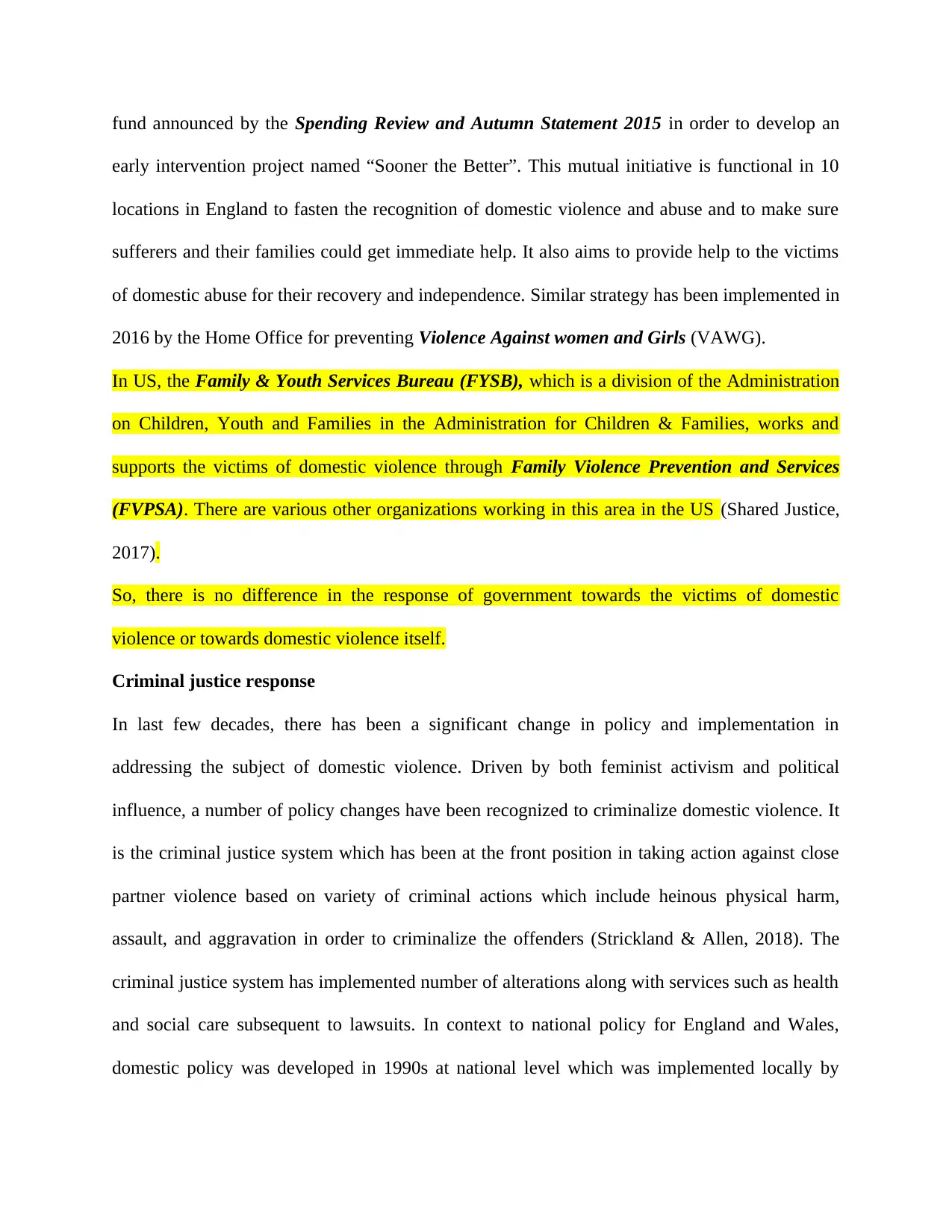
fund announced by the Spending Review and Autumn Statement 2015 in order to develop an
early intervention project named “Sooner the Better”. This mutual initiative is functional in 10
locations in England to fasten the recognition of domestic violence and abuse and to make sure
sufferers and their families could get immediate help. It also aims to provide help to the victims
of domestic abuse for their recovery and independence. Similar strategy has been implemented in
2016 by the Home Office for preventing Violence Against women and Girls (VAWG).
In US, the Family & Youth Services Bureau (FYSB), which is a division of the Administration
on Children, Youth and Families in the Administration for Children & Families, works and
supports the victims of domestic violence through Family Violence Prevention and Services
(FVPSA). There are various other organizations working in this area in the US (Shared Justice,
2017).
So, there is no difference in the response of government towards the victims of domestic
violence or towards domestic violence itself.
Criminal justice response
In last few decades, there has been a significant change in policy and implementation in
addressing the subject of domestic violence. Driven by both feminist activism and political
influence, a number of policy changes have been recognized to criminalize domestic violence. It
is the criminal justice system which has been at the front position in taking action against close
partner violence based on variety of criminal actions which include heinous physical harm,
assault, and aggravation in order to criminalize the offenders (Strickland & Allen, 2018). The
criminal justice system has implemented number of alterations along with services such as health
and social care subsequent to lawsuits. In context to national policy for England and Wales,
domestic policy was developed in 1990s at national level which was implemented locally by
early intervention project named “Sooner the Better”. This mutual initiative is functional in 10
locations in England to fasten the recognition of domestic violence and abuse and to make sure
sufferers and their families could get immediate help. It also aims to provide help to the victims
of domestic abuse for their recovery and independence. Similar strategy has been implemented in
2016 by the Home Office for preventing Violence Against women and Girls (VAWG).
In US, the Family & Youth Services Bureau (FYSB), which is a division of the Administration
on Children, Youth and Families in the Administration for Children & Families, works and
supports the victims of domestic violence through Family Violence Prevention and Services
(FVPSA). There are various other organizations working in this area in the US (Shared Justice,
2017).
So, there is no difference in the response of government towards the victims of domestic
violence or towards domestic violence itself.
Criminal justice response
In last few decades, there has been a significant change in policy and implementation in
addressing the subject of domestic violence. Driven by both feminist activism and political
influence, a number of policy changes have been recognized to criminalize domestic violence. It
is the criminal justice system which has been at the front position in taking action against close
partner violence based on variety of criminal actions which include heinous physical harm,
assault, and aggravation in order to criminalize the offenders (Strickland & Allen, 2018). The
criminal justice system has implemented number of alterations along with services such as health
and social care subsequent to lawsuits. In context to national policy for England and Wales,
domestic policy was developed in 1990s at national level which was implemented locally by
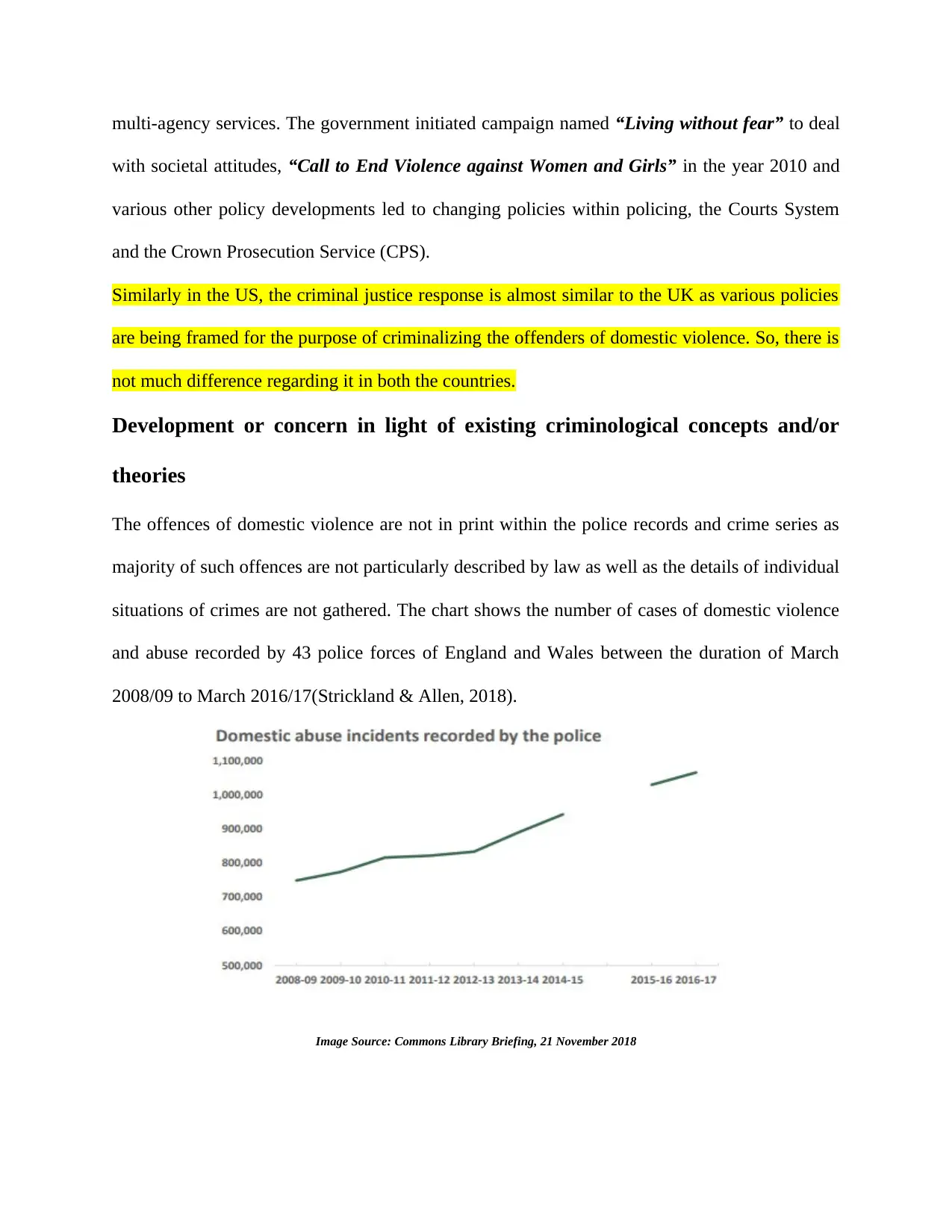
multi-agency services. The government initiated campaign named “Living without fear” to deal
with societal attitudes, “Call to End Violence against Women and Girls” in the year 2010 and
various other policy developments led to changing policies within policing, the Courts System
and the Crown Prosecution Service (CPS).
Similarly in the US, the criminal justice response is almost similar to the UK as various policies
are being framed for the purpose of criminalizing the offenders of domestic violence. So, there is
not much difference regarding it in both the countries.
Development or concern in light of existing criminological concepts and/or
theories
The offences of domestic violence are not in print within the police records and crime series as
majority of such offences are not particularly described by law as well as the details of individual
situations of crimes are not gathered. The chart shows the number of cases of domestic violence
and abuse recorded by 43 police forces of England and Wales between the duration of March
2008/09 to March 2016/17(Strickland & Allen, 2018).
Image Source: Commons Library Briefing, 21 November 2018
with societal attitudes, “Call to End Violence against Women and Girls” in the year 2010 and
various other policy developments led to changing policies within policing, the Courts System
and the Crown Prosecution Service (CPS).
Similarly in the US, the criminal justice response is almost similar to the UK as various policies
are being framed for the purpose of criminalizing the offenders of domestic violence. So, there is
not much difference regarding it in both the countries.
Development or concern in light of existing criminological concepts and/or
theories
The offences of domestic violence are not in print within the police records and crime series as
majority of such offences are not particularly described by law as well as the details of individual
situations of crimes are not gathered. The chart shows the number of cases of domestic violence
and abuse recorded by 43 police forces of England and Wales between the duration of March
2008/09 to March 2016/17(Strickland & Allen, 2018).
Image Source: Commons Library Briefing, 21 November 2018
⊘ This is a preview!⊘
Do you want full access?
Subscribe today to unlock all pages.

Trusted by 1+ million students worldwide
1 out of 21
Related Documents
Your All-in-One AI-Powered Toolkit for Academic Success.
+13062052269
info@desklib.com
Available 24*7 on WhatsApp / Email
![[object Object]](/_next/static/media/star-bottom.7253800d.svg)
Unlock your academic potential
Copyright © 2020–2025 A2Z Services. All Rights Reserved. Developed and managed by ZUCOL.





